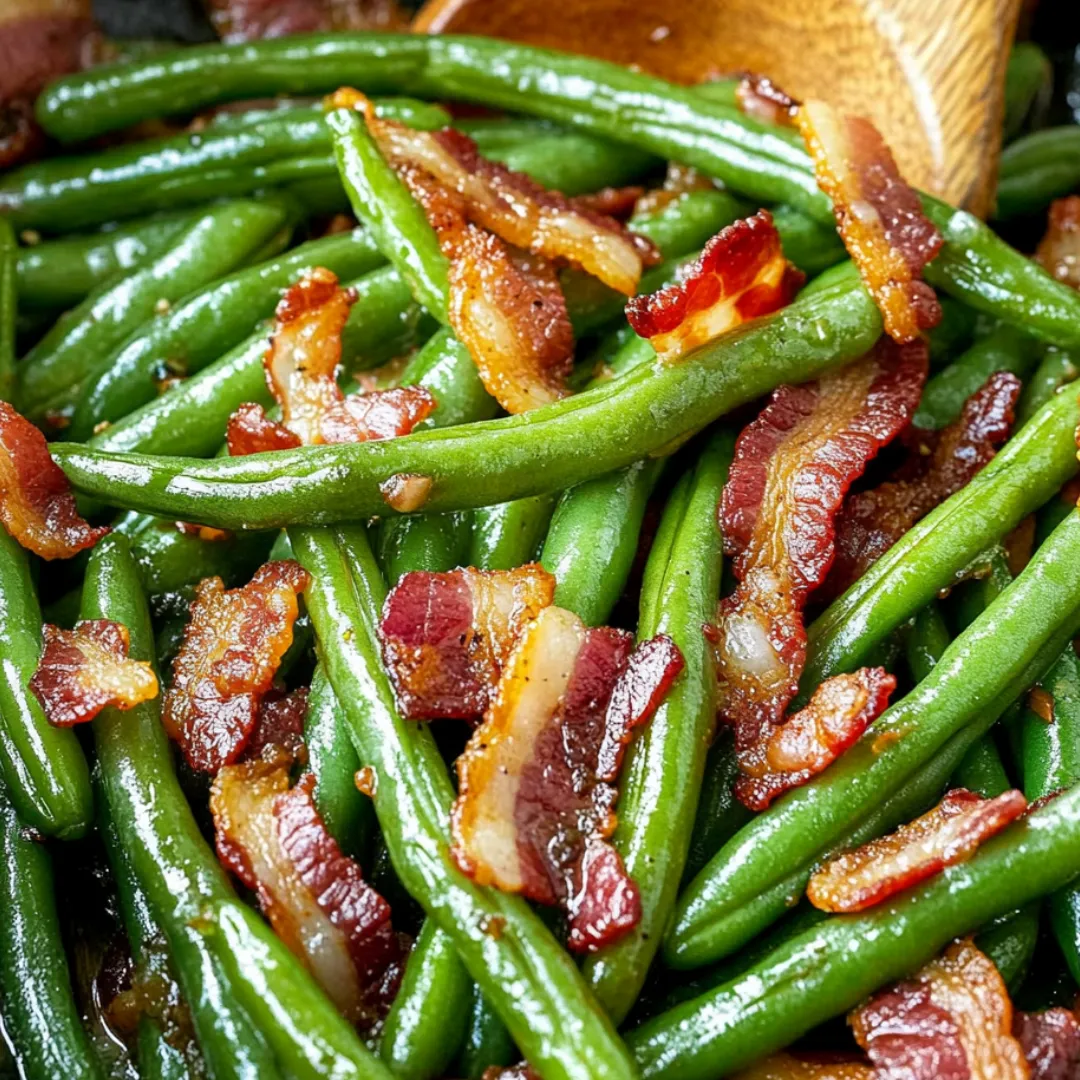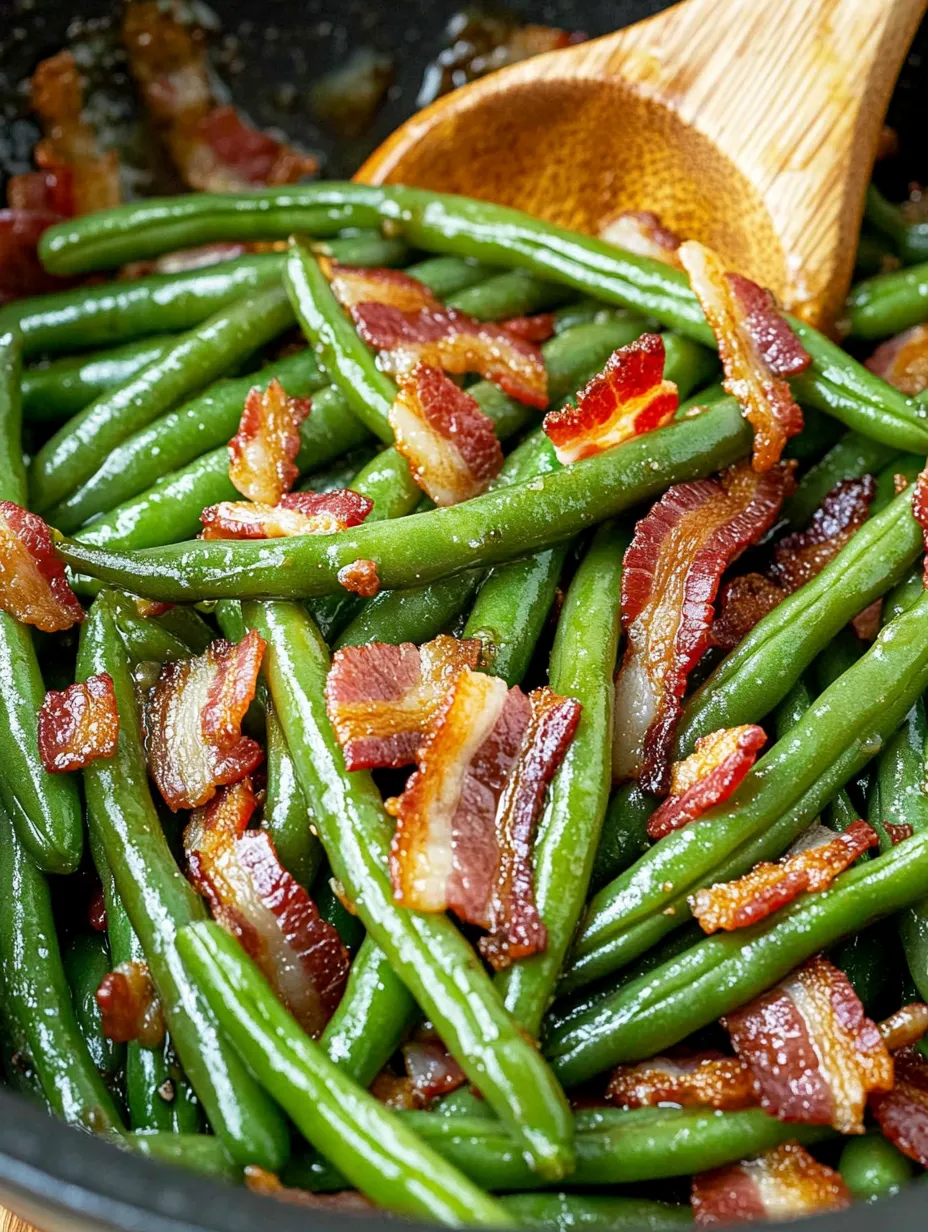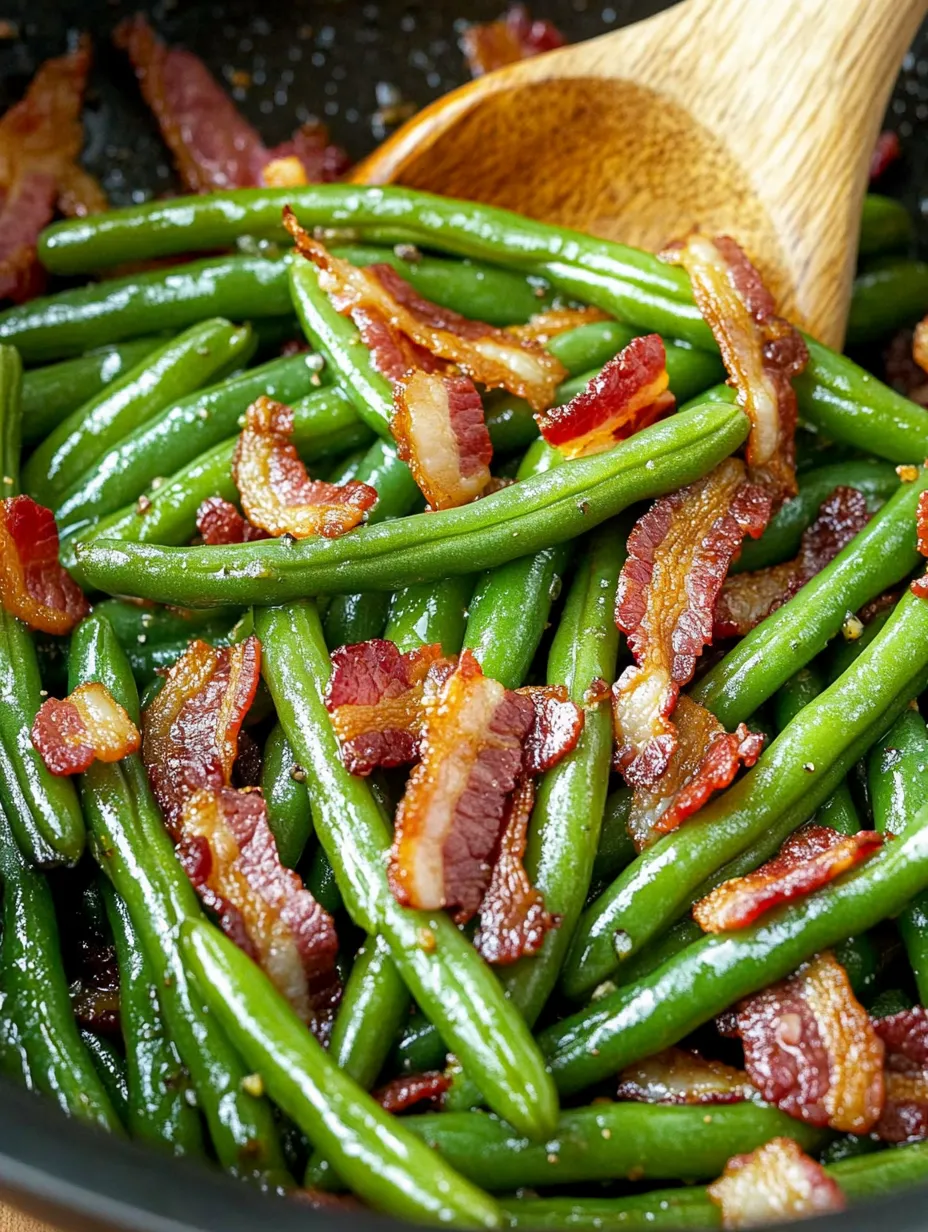 Pin it
Pin it
These crispy-tender green beans transform a humble vegetable into something truly crave-worthy with minimal effort. The magic happens when fresh beans meet caramelized onions and smoky bacon, creating a perfect balance of textures and flavors that elevate this simple side dish to star status. The beans maintain their bright color and satisfying snap while soaking up the rich flavors of garlic and bacon. Ready in under 30 minutes with just a handful of ingredients, this versatile side dish complements everything from weeknight chicken to holiday turkey. It's the veggie dish that consistently disappears first, even from tables loaded with traditional favorites.
I discovered this method years ago when struggling to find vegetable sides my family would actually finish. My first 'aha' moment came when I noticed my vegetable-avoiding nephew taking seconds, then thirds of these beans at a holiday dinner. What surprised me most was how the caramelized onions created a natural sweetness that balanced the savory bacon perfectly. Now this dish appears on our table year-round, and I've learned to make extra because everyone reaches for more – something I never thought I'd see with green beans!
Essential Ingredients
- 1 pound Fresh Green Beans: Look for bright, vibrant beans that snap when bent. Younger, thinner beans offer better texture and less stringiness. Trim both ends before cooking for the best eating experience
- 4-6 slices Bacon: Provides smoky depth and irresistible crispy bits. Thick-cut bacon offers more substantial texture, but regular bacon works beautifully too. The rendered fat becomes the flavor base for the entire dish
- 1 medium Onion: Creates sweet, caramelized notes that balance the savory elements. Slice it thinly for faster caramelization and more even distribution throughout the dish
- 4-5 cloves Garlic: Adds aromatic depth that mellows during cooking. Slice rather than mince to prevent burning and sticking to the pan
- 1 tablespoon Butter: Added at the end for richness and a beautiful glossy finish. Use unsalted butter to maintain better control over the final seasoning
- Salt and Freshly Ground Black Pepper: Simple seasonings that allow the fresh vegetable flavor to shine through. Season with a light hand initially, as the bacon adds saltiness
- 2 tablespoons Water or Chicken Stock: Creates steam for perfectly cooking the beans while maintaining their color. Stock adds an extra layer of flavor if you have it on hand
 Pin it
Pin it
Step-by-Step Cooking Instructions
- Prepare the Green Beans:
- Start with fresh, bright green beans that snap when bent – this indicates peak freshness. Trim both ends by lining up a handful on your cutting board and slicing off the tips with one clean cut. If your beans are particularly long, cut them in half for easier eating and more consistent cooking. Wash thoroughly in cold water and pat completely dry with a clean kitchen towel. Wet beans will steam rather than sear, preventing proper caramelization. This thorough drying step often gets overlooked but makes a significant difference in the final texture.
- Cook the Bacon to Perfection:
- Begin with a cold, large 12-inch skillet – preferably cast iron for optimal heat retention and distribution. Cut your bacon into 1-inch pieces using kitchen shears for ease and place them in the cold skillet. Starting with a cold pan allows the fat to render slowly, resulting in evenly crisp bacon without burning. Turn the heat to medium and cook, stirring occasionally, until the bacon is golden brown and crispy, about 5-7 minutes. Using a slotted spoon, transfer the bacon to a paper towel-lined plate to drain excess grease. Leave about 2 tablespoons of the rendered bacon fat in the skillet – this becomes the flavor foundation for your beans.
- Caramelize the Onions:
- With the bacon fat still in the pan, add your thinly sliced onion to the skillet. Cook over medium heat, stirring occasionally, until the onions begin to soften and turn translucent, about a full 5 minutes. Don't rush this step by using high heat – slower cooking develops deeper flavor without burning. The onions should just begin to show hints of golden color at the edges but shouldn't be fully caramelized yet, as they'll continue cooking with the beans. If you find the onions browning too quickly, reduce the heat slightly.
- Add the Beans and Garlic:
- Once your onions are softened with hints of golden color, add the prepared green beans to the skillet along with the sliced garlic. Season with a generous pinch of salt and freshly ground black pepper. Toss everything together to coat the beans evenly with the bacon fat and distribute the onions throughout. Increase the heat to medium-high and cook for about 1 minute, stirring frequently to prevent the garlic from burning. This initial searing helps develop flavor while maintaining the beans' bright color.
- Steam to Perfect Tenderness:
- After searing the beans, add 2 tablespoons of water or chicken stock to the hot skillet. The liquid will sizzle immediately – quickly cover the skillet with a tight-fitting lid to trap the steam. Reduce heat to medium and let the beans steam for 3-5 minutes, depending on their thickness and your preferred level of crispness. The beans are done when they're vibrant green and tender-crisp when pierced with a fork but still have a slight snap when bitten. Check them at the 3-minute mark to avoid overcooking – properly cooked green beans should never be dull or mushy.
- Finish with Butter and Bacon:
- Once the beans reach your desired tenderness, remove the lid and increase the heat to medium-high. Cook for another minute to evaporate any remaining liquid, tossing frequently. Add the tablespoon of butter and stir until melted and coating the beans with a glossy sheen. Return the crispy bacon pieces to the skillet and toss everything together for 30 seconds to reheat the bacon and allow the flavors to meld. Taste and adjust seasoning with additional salt and pepper if needed, keeping in mind that the bacon adds significant saltiness.
- Serve Immediately:
- Transfer to a warm serving dish and bring straight to the table. These beans are at their peak when freshly cooked, with the perfect contrast between the tender-crisp vegetable and the crispy bacon bits. The bright green color and glossy butter finish make this dish as visually appealing as it is delicious. For special occasions, consider garnishing with a sprinkle of toasted sliced almonds or a few fresh herb leaves like thyme or parsley for added visual interest.
Growing up, green beans typically meant mushy, olive-colored vegetables from a can that nobody wanted to eat. My grandmother would try to convince us they were delicious by adding a ton of butter, but we weren't fooled. The first time I tried this method with fresh beans, I was amazed at how different they tasted – bright, fresh, and actually vegetable-like! Now my own children fight over the last serving, which feels like winning the parenting lottery where vegetables are concerned. My husband, who claimed to hate all green vegetables, now specifically requests these beans when I ask what sides he wants with dinner.
The Art of Bean Selection
Finding the perfect green beans makes all the difference in this dish. Look beyond just color to evaluate freshness and quality. The ideal beans should be slender rather than bulging (which indicates overlarge seeds inside), have a smooth surface without wrinkles, and make a distinct snapping sound when bent. Early morning farmers' market shopping often yields the freshest beans, harvested just hours before. When shopping at groceries, check the cut ends – they should look fresh and not dried out or discolored. If you can only find slightly older beans, consider blanching them briefly in boiling water before sautéing to revive their color and texture. While fresh beans absolutely make the best version of this dish, frozen haricots verts (French green beans) can work in a pinch – just thaw completely, pat dry, and reduce the steam time by half since they're partially cooked.
Seasonal Adaptations
This versatile recipe welcomes seasonal adjustments throughout the year. In spring, add halved sugar snap peas alongside the green beans for textural contrast and natural sweetness. Summer invites the addition of corn kernels cut fresh from the cob or halved cherry tomatoes added in the final minute of cooking. Fall calls for a handful of toasted walnuts or pecans sprinkled over the finished dish, while winter welcomes a pinch of red pepper flakes for warming heat. During holiday seasons, dress this side up with a sprinkle of dried cranberries added after cooking for beautiful color contrast and bursts of sweet-tart flavor. These thoughtful seasonal touches keep a reliable recipe feeling fresh and relevant year-round while maintaining its essential character.
Perfect Pairing Suggestions
Finding the right main dish to accompany these green beans can create a truly memorable meal. For weeknight dinners, they complement simple roasted chicken or grilled pork chops beautifully, adding color and fresh flavor to counter richer proteins. During the holidays, they offer a welcome brightness alongside turkey and stuffing, providing textural contrast to softer traditional sides. For elegant entertaining, consider serving alongside beef tenderloin, where the beans' slight crispness and bacon's smokiness enhance the meat's richness. Fish dishes particularly benefit from this side – the bacon provides just enough savory depth to stand up to salmon or sea bass without overwhelming more delicate flavors. For vegetarian meals, these beans make a substantial side to mushroom risotto or roasted root vegetables, with the bacon omitted and perhaps a sprinkle of smoked paprika added to maintain that hint of smokiness.
 Pin it
Pin it
Troubleshooting Common Issues
Even experienced cooks occasionally encounter challenges with vegetable sides. If your beans aren't developing the caramelized spots you desire, check that they're completely dry before adding to the pan and that your skillet is truly hot enough – water on the surface prevents proper browning. Should your onions burn rather than caramelize, your heat is likely too high; lower it and consider adding a small splash of water to slow the process. For beans that remain too tough despite adequate cooking time, they may be past their prime; older beans require longer cooking or pre-blanching to achieve ideal tenderness. If your final dish seems greasy, your bacon likely rendered more fat than needed; pour off excess fat after cooking the bacon, leaving just 1-2 tablespoons in the pan. These simple adjustments can transform good green beans into exceptional ones.
After years of vegetable side dish experiments, I've found that the simplest preparations often create the most satisfying results. These green beans with bacon embody that philosophy perfectly – just a few quality ingredients, treated with respect, creating something greater than the sum of its parts. The contrast of textures between the tender-crisp beans and the crispy bacon, the balance of the sweet caramelized onions with the savory garlic – this dish proves that vegetables can be far more than an obligation on our plates. There's something deeply satisfying about transforming a humble green bean into something that family members actually request, and watching previously vegetable-averse friends or children reach for seconds reminds me why I love cooking in the first place. It's not always about elaborate techniques or exotic ingredients – sometimes it's simply about knowing how to bring out the best in what's already there.
Frequently Asked Questions
- → How do I keep green beans bright green when cooking?
- The key is to avoid overcooking them. The quick steam method in this recipe (4-5 minutes covered) followed by removing the lid helps maintain their color. If you want even brighter green beans, you can blanch them in boiling water for 2 minutes, then shock in ice water before adding to the skillet.
- → Can I make this dish ahead of time?
- Yes, you can prepare it up to a day ahead. Slightly undercook the beans (about 3-4 minutes of steaming), then reheat in a skillet when ready to serve. Add the bacon just before serving to maintain its crispiness.
- → What can I substitute for bacon?
- Pancetta makes an excellent substitute with a similar smoky flavor. For a meatless version, use smoked paprika (1/2 teaspoon) and extra olive oil to mimic the smoky flavor of bacon. Vegetarian bacon substitutes also work well.
- → Are frozen green beans suitable for this recipe?
- Yes, but the texture won't be quite the same as fresh. Thaw and pat dry before using. Reduce the steaming time to 2-3 minutes since frozen beans are typically pre-blanched. For best results, use fresh green beans when possible.
- → What main dishes pair well with these green beans?
- These green beans complement almost any protein. They're especially good with roasted chicken, grilled steak, baked ham, or meatloaf. For holiday meals, they're perfect alongside turkey or prime rib. They also work well with fish like salmon or halibut.
